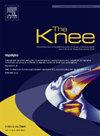骨水泥过敏和轻度骨质流失患者改良全膝关节置换术中的干骺端套管:一个病例系列
IF 2
4区 医学
Q3 ORTHOPEDICS
引用次数: 0
摘要
背景:在评估全膝关节置换术(TKA)后的持续性膝关节炎症时,一旦排除了其他原因,应考虑对植入物部件的过敏。翻修全膝关节置换术(rTKA)在患者骨水泥过敏提出了一个独特的挑战。方法本研究报告4例TKA临床失败的患者,其中3例经皮肤贴试验证实对聚甲基丙烯酸甲酯(PMMA)过敏,1例对过氧化苯甲酰过敏。所有患者均采用干骺端套管进行rTKA。在3例中,骨干干也被使用。结果平均随访71.2个月后,所有患者均出现症状改善,活动范围(ROM)平均增加12.5度。膝关节社会评分平均增加了16.75分。没有人需要额外的手术。结论:对于确认对骨水泥过敏且骨质流失较少的患者,采用干骺端套管(单独使用或与干骺端套管联合使用)是一种可行的无骨水泥固定策略,中期效果良好。本文章由计算机程序翻译,如有差异,请以英文原文为准。
Metaphyseal sleeves for revision total knee arthroplasty for patients with bone cement allergy and minimal bone loss: a case series
Background
When evaluating persistent knee inflammation following total knee arthroplasty (TKA), hypersensitivity to implant components should be considered once other causes have been excluded. Revision total knee arthroplasty (rTKA) in patients with bone cement hypersensitivity presents a unique challenge.
Method
This study reports on four patients with clinical failure of TKA, three with confirmed allergy to polymethyl methacrylate (PMMA) and one to benzoyl peroxide, as demonstrated by skin patch testing. All patients underwent rTKA using metaphyseal sleeves. In three cases, diaphyseal stems were also used.
Results
After a mean follow-up of 71.2 months, all patients experienced symptomatic improvement, with a mean increase in range of motion (ROM) of 12.5 degrees. There was a mean increase of 16, 75 points in Knee Society Score. None required additional surgery.
Conclusion
In patients undergoing revision TKA due to confirmed allergy to bone cement and minimal bone loss, the use of metaphyseal sleeves—alone or in combination with stems—provides a viable cementless fixation strategy with promising mid-term outcomes.
求助全文
通过发布文献求助,成功后即可免费获取论文全文。
去求助
来源期刊

Knee
医学-外科
CiteScore
3.80
自引率
5.30%
发文量
171
审稿时长
6 months
期刊介绍:
The Knee is an international journal publishing studies on the clinical treatment and fundamental biomechanical characteristics of this joint. The aim of the journal is to provide a vehicle relevant to surgeons, biomedical engineers, imaging specialists, materials scientists, rehabilitation personnel and all those with an interest in the knee.
The topics covered include, but are not limited to:
• Anatomy, physiology, morphology and biochemistry;
• Biomechanical studies;
• Advances in the development of prosthetic, orthotic and augmentation devices;
• Imaging and diagnostic techniques;
• Pathology;
• Trauma;
• Surgery;
• Rehabilitation.
 求助内容:
求助内容: 应助结果提醒方式:
应助结果提醒方式:


